Report: First Aid Trainer Roles, Assessments, and Learning Needs
VerifiedAdded on 2022/08/12
|10
|2140
|10
Report
AI Summary
This report provides a comprehensive analysis of the roles and responsibilities of a first aid trainer in the United Kingdom, focusing on the development of first aid learners. It explores the importance of identifying and meeting learner needs through initial and diagnostic assessments, detailing their significance in tailoring training programs and fostering effective learning. The report emphasizes the trainer's multifaceted roles, including leader, course designer, and subject expert, and highlights the importance of maintaining a safe and inclusive training environment. Furthermore, it references relevant UK legislation and codes of practice, such as the Equality Act 2010 and the Education and Inspection Act 2006, to ensure quality and equality in first aid education. The conclusion underscores the critical role of first aid trainers in society and the necessity of continuous assessment and a supportive learning atmosphere. The report also provides a detailed bibliography of sources used.
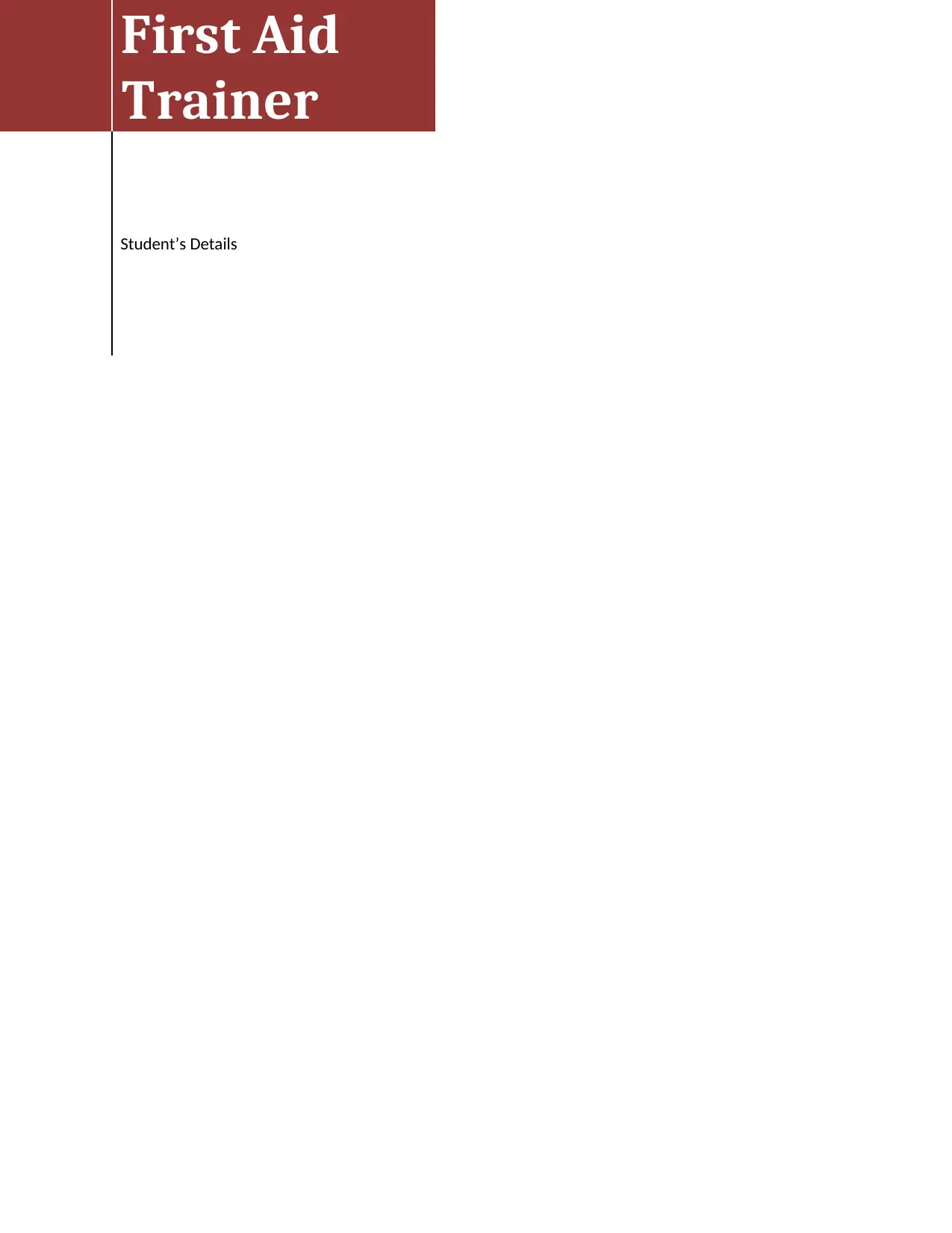
First Aid
Trainer
Student’s Details
Trainer
Student’s Details
Paraphrase This Document
Need a fresh take? Get an instant paraphrase of this document with our AI Paraphraser
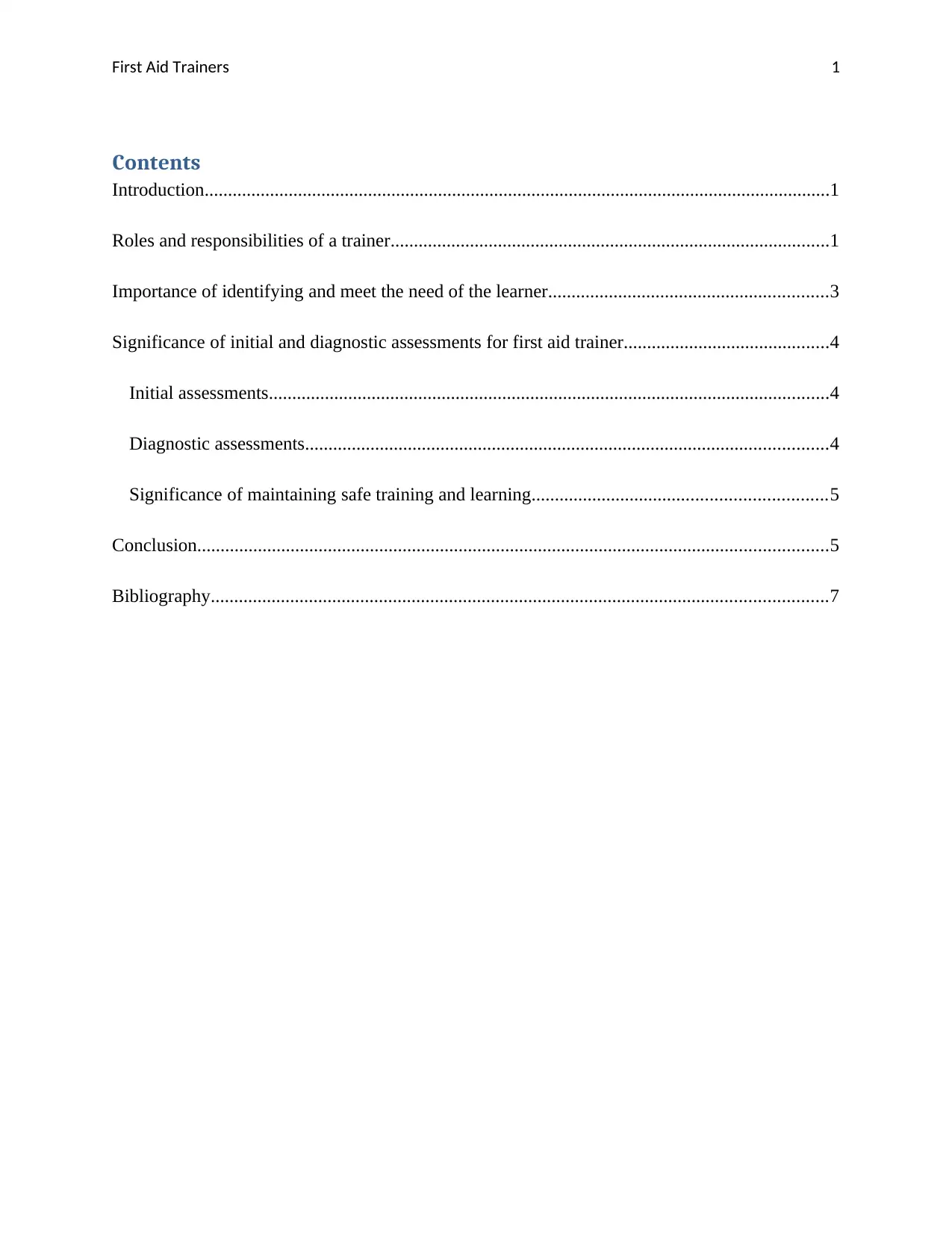
First Aid Trainers 1
Contents
Introduction......................................................................................................................................1
Roles and responsibilities of a trainer..............................................................................................1
Importance of identifying and meet the need of the learner............................................................3
Significance of initial and diagnostic assessments for first aid trainer............................................4
Initial assessments........................................................................................................................4
Diagnostic assessments................................................................................................................4
Significance of maintaining safe training and learning...............................................................5
Conclusion.......................................................................................................................................5
Bibliography....................................................................................................................................7
Contents
Introduction......................................................................................................................................1
Roles and responsibilities of a trainer..............................................................................................1
Importance of identifying and meet the need of the learner............................................................3
Significance of initial and diagnostic assessments for first aid trainer............................................4
Initial assessments........................................................................................................................4
Diagnostic assessments................................................................................................................4
Significance of maintaining safe training and learning...............................................................5
Conclusion.......................................................................................................................................5
Bibliography....................................................................................................................................7
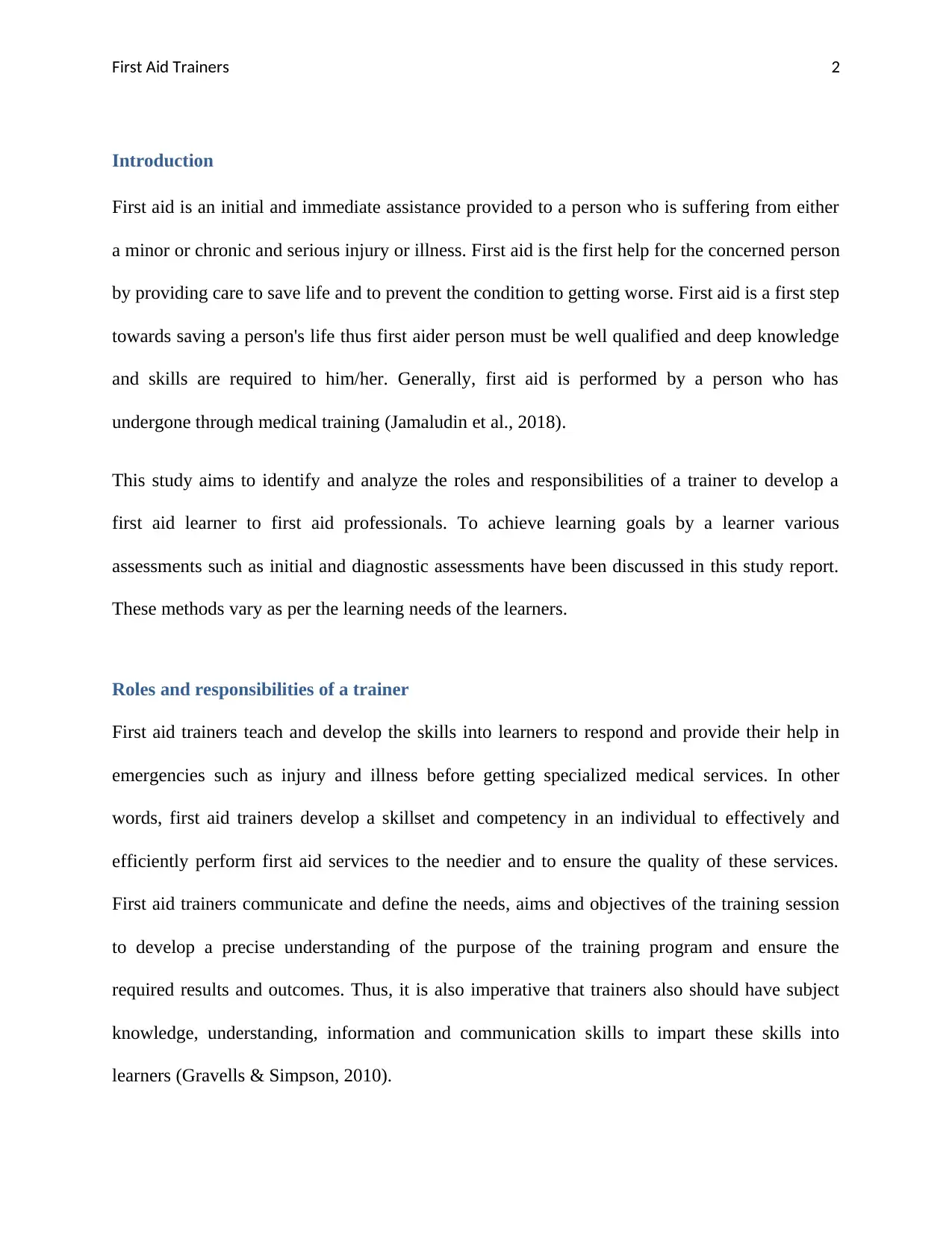
First Aid Trainers 2
Introduction
First aid is an initial and immediate assistance provided to a person who is suffering from either
a minor or chronic and serious injury or illness. First aid is the first help for the concerned person
by providing care to save life and to prevent the condition to getting worse. First aid is a first step
towards saving a person's life thus first aider person must be well qualified and deep knowledge
and skills are required to him/her. Generally, first aid is performed by a person who has
undergone through medical training (Jamaludin et al., 2018).
This study aims to identify and analyze the roles and responsibilities of a trainer to develop a
first aid learner to first aid professionals. To achieve learning goals by a learner various
assessments such as initial and diagnostic assessments have been discussed in this study report.
These methods vary as per the learning needs of the learners.
Roles and responsibilities of a trainer
First aid trainers teach and develop the skills into learners to respond and provide their help in
emergencies such as injury and illness before getting specialized medical services. In other
words, first aid trainers develop a skillset and competency in an individual to effectively and
efficiently perform first aid services to the needier and to ensure the quality of these services.
First aid trainers communicate and define the needs, aims and objectives of the training session
to develop a precise understanding of the purpose of the training program and ensure the
required results and outcomes. Thus, it is also imperative that trainers also should have subject
knowledge, understanding, information and communication skills to impart these skills into
learners (Gravells & Simpson, 2010).
Introduction
First aid is an initial and immediate assistance provided to a person who is suffering from either
a minor or chronic and serious injury or illness. First aid is the first help for the concerned person
by providing care to save life and to prevent the condition to getting worse. First aid is a first step
towards saving a person's life thus first aider person must be well qualified and deep knowledge
and skills are required to him/her. Generally, first aid is performed by a person who has
undergone through medical training (Jamaludin et al., 2018).
This study aims to identify and analyze the roles and responsibilities of a trainer to develop a
first aid learner to first aid professionals. To achieve learning goals by a learner various
assessments such as initial and diagnostic assessments have been discussed in this study report.
These methods vary as per the learning needs of the learners.
Roles and responsibilities of a trainer
First aid trainers teach and develop the skills into learners to respond and provide their help in
emergencies such as injury and illness before getting specialized medical services. In other
words, first aid trainers develop a skillset and competency in an individual to effectively and
efficiently perform first aid services to the needier and to ensure the quality of these services.
First aid trainers communicate and define the needs, aims and objectives of the training session
to develop a precise understanding of the purpose of the training program and ensure the
required results and outcomes. Thus, it is also imperative that trainers also should have subject
knowledge, understanding, information and communication skills to impart these skills into
learners (Gravells & Simpson, 2010).
⊘ This is a preview!⊘
Do you want full access?
Subscribe today to unlock all pages.

Trusted by 1+ million students worldwide
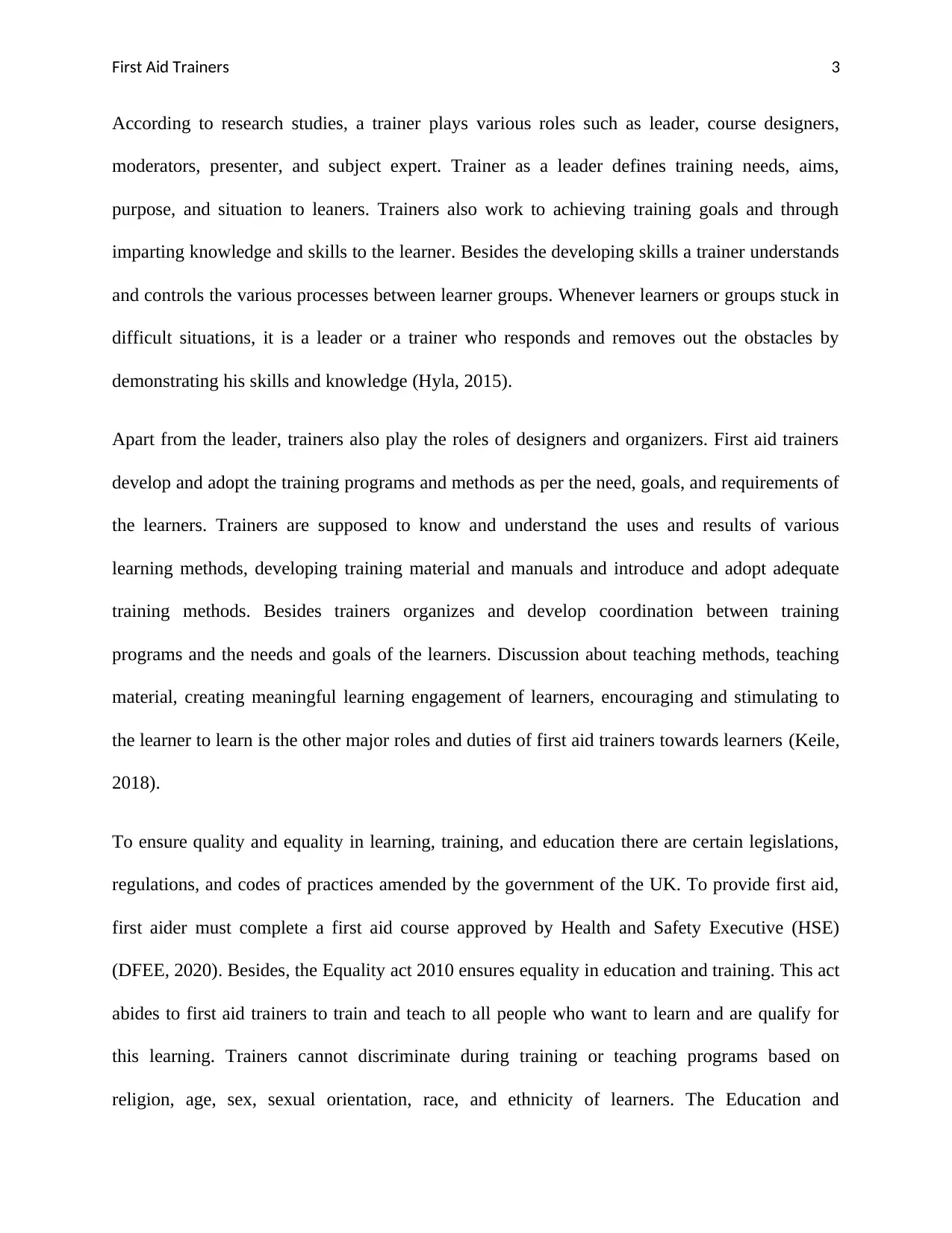
First Aid Trainers 3
According to research studies, a trainer plays various roles such as leader, course designers,
moderators, presenter, and subject expert. Trainer as a leader defines training needs, aims,
purpose, and situation to leaners. Trainers also work to achieving training goals and through
imparting knowledge and skills to the learner. Besides the developing skills a trainer understands
and controls the various processes between learner groups. Whenever learners or groups stuck in
difficult situations, it is a leader or a trainer who responds and removes out the obstacles by
demonstrating his skills and knowledge (Hyla, 2015).
Apart from the leader, trainers also play the roles of designers and organizers. First aid trainers
develop and adopt the training programs and methods as per the need, goals, and requirements of
the learners. Trainers are supposed to know and understand the uses and results of various
learning methods, developing training material and manuals and introduce and adopt adequate
training methods. Besides trainers organizes and develop coordination between training
programs and the needs and goals of the learners. Discussion about teaching methods, teaching
material, creating meaningful learning engagement of learners, encouraging and stimulating to
the learner to learn is the other major roles and duties of first aid trainers towards learners (Keile,
2018).
To ensure quality and equality in learning, training, and education there are certain legislations,
regulations, and codes of practices amended by the government of the UK. To provide first aid,
first aider must complete a first aid course approved by Health and Safety Executive (HSE)
(DFEE, 2020). Besides, the Equality act 2010 ensures equality in education and training. This act
abides to first aid trainers to train and teach to all people who want to learn and are qualify for
this learning. Trainers cannot discriminate during training or teaching programs based on
religion, age, sex, sexual orientation, race, and ethnicity of learners. The Education and
According to research studies, a trainer plays various roles such as leader, course designers,
moderators, presenter, and subject expert. Trainer as a leader defines training needs, aims,
purpose, and situation to leaners. Trainers also work to achieving training goals and through
imparting knowledge and skills to the learner. Besides the developing skills a trainer understands
and controls the various processes between learner groups. Whenever learners or groups stuck in
difficult situations, it is a leader or a trainer who responds and removes out the obstacles by
demonstrating his skills and knowledge (Hyla, 2015).
Apart from the leader, trainers also play the roles of designers and organizers. First aid trainers
develop and adopt the training programs and methods as per the need, goals, and requirements of
the learners. Trainers are supposed to know and understand the uses and results of various
learning methods, developing training material and manuals and introduce and adopt adequate
training methods. Besides trainers organizes and develop coordination between training
programs and the needs and goals of the learners. Discussion about teaching methods, teaching
material, creating meaningful learning engagement of learners, encouraging and stimulating to
the learner to learn is the other major roles and duties of first aid trainers towards learners (Keile,
2018).
To ensure quality and equality in learning, training, and education there are certain legislations,
regulations, and codes of practices amended by the government of the UK. To provide first aid,
first aider must complete a first aid course approved by Health and Safety Executive (HSE)
(DFEE, 2020). Besides, the Equality act 2010 ensures equality in education and training. This act
abides to first aid trainers to train and teach to all people who want to learn and are qualify for
this learning. Trainers cannot discriminate during training or teaching programs based on
religion, age, sex, sexual orientation, race, and ethnicity of learners. The Education and
Paraphrase This Document
Need a fresh take? Get an instant paraphrase of this document with our AI Paraphraser
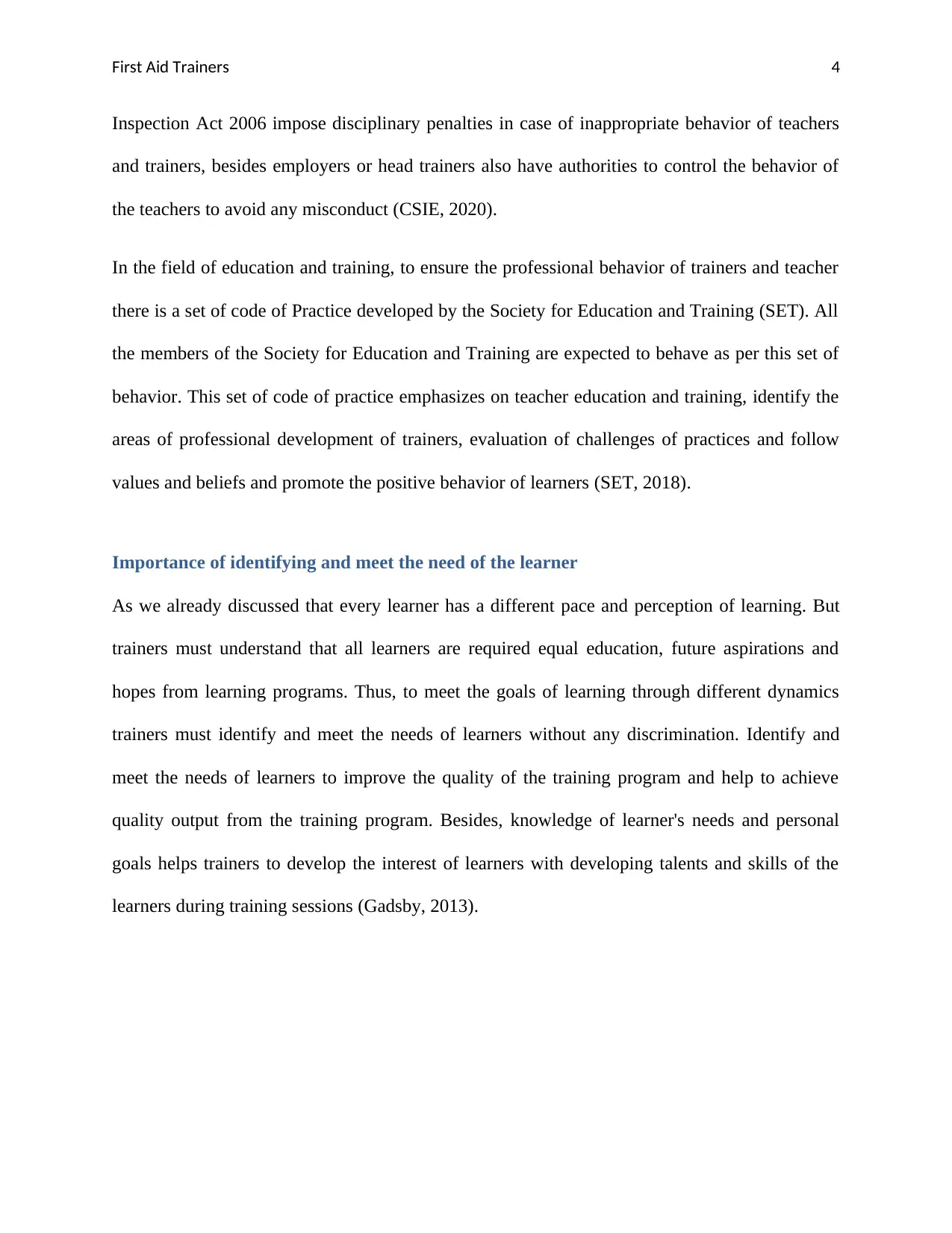
First Aid Trainers 4
Inspection Act 2006 impose disciplinary penalties in case of inappropriate behavior of teachers
and trainers, besides employers or head trainers also have authorities to control the behavior of
the teachers to avoid any misconduct (CSIE, 2020).
In the field of education and training, to ensure the professional behavior of trainers and teacher
there is a set of code of Practice developed by the Society for Education and Training (SET). All
the members of the Society for Education and Training are expected to behave as per this set of
behavior. This set of code of practice emphasizes on teacher education and training, identify the
areas of professional development of trainers, evaluation of challenges of practices and follow
values and beliefs and promote the positive behavior of learners (SET, 2018).
Importance of identifying and meet the need of the learner
As we already discussed that every learner has a different pace and perception of learning. But
trainers must understand that all learners are required equal education, future aspirations and
hopes from learning programs. Thus, to meet the goals of learning through different dynamics
trainers must identify and meet the needs of learners without any discrimination. Identify and
meet the needs of learners to improve the quality of the training program and help to achieve
quality output from the training program. Besides, knowledge of learner's needs and personal
goals helps trainers to develop the interest of learners with developing talents and skills of the
learners during training sessions (Gadsby, 2013).
Inspection Act 2006 impose disciplinary penalties in case of inappropriate behavior of teachers
and trainers, besides employers or head trainers also have authorities to control the behavior of
the teachers to avoid any misconduct (CSIE, 2020).
In the field of education and training, to ensure the professional behavior of trainers and teacher
there is a set of code of Practice developed by the Society for Education and Training (SET). All
the members of the Society for Education and Training are expected to behave as per this set of
behavior. This set of code of practice emphasizes on teacher education and training, identify the
areas of professional development of trainers, evaluation of challenges of practices and follow
values and beliefs and promote the positive behavior of learners (SET, 2018).
Importance of identifying and meet the need of the learner
As we already discussed that every learner has a different pace and perception of learning. But
trainers must understand that all learners are required equal education, future aspirations and
hopes from learning programs. Thus, to meet the goals of learning through different dynamics
trainers must identify and meet the needs of learners without any discrimination. Identify and
meet the needs of learners to improve the quality of the training program and help to achieve
quality output from the training program. Besides, knowledge of learner's needs and personal
goals helps trainers to develop the interest of learners with developing talents and skills of the
learners during training sessions (Gadsby, 2013).
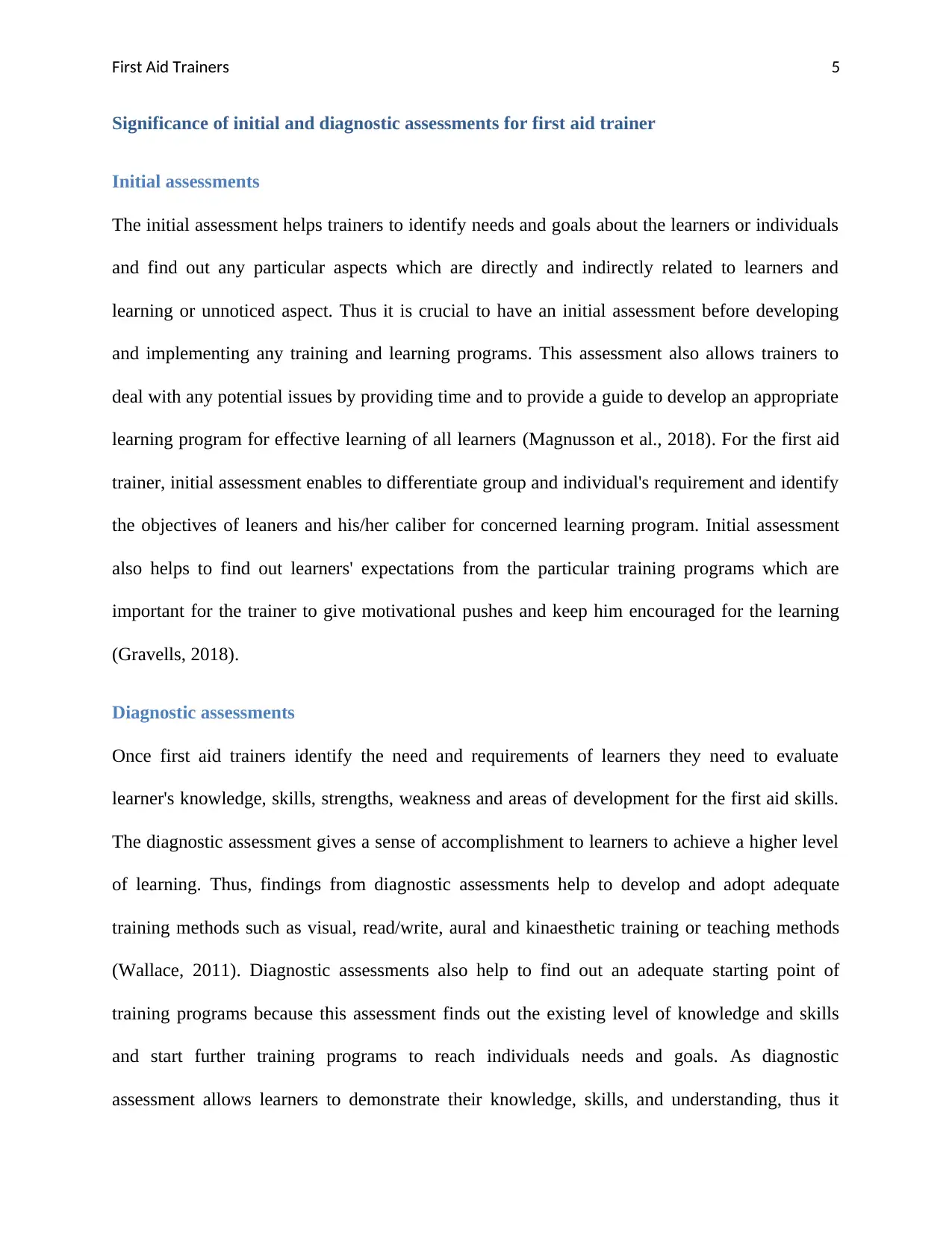
First Aid Trainers 5
Significance of initial and diagnostic assessments for first aid trainer
Initial assessments
The initial assessment helps trainers to identify needs and goals about the learners or individuals
and find out any particular aspects which are directly and indirectly related to learners and
learning or unnoticed aspect. Thus it is crucial to have an initial assessment before developing
and implementing any training and learning programs. This assessment also allows trainers to
deal with any potential issues by providing time and to provide a guide to develop an appropriate
learning program for effective learning of all learners (Magnusson et al., 2018). For the first aid
trainer, initial assessment enables to differentiate group and individual's requirement and identify
the objectives of leaners and his/her caliber for concerned learning program. Initial assessment
also helps to find out learners' expectations from the particular training programs which are
important for the trainer to give motivational pushes and keep him encouraged for the learning
(Gravells, 2018).
Diagnostic assessments
Once first aid trainers identify the need and requirements of learners they need to evaluate
learner's knowledge, skills, strengths, weakness and areas of development for the first aid skills.
The diagnostic assessment gives a sense of accomplishment to learners to achieve a higher level
of learning. Thus, findings from diagnostic assessments help to develop and adopt adequate
training methods such as visual, read/write, aural and kinaesthetic training or teaching methods
(Wallace, 2011). Diagnostic assessments also help to find out an adequate starting point of
training programs because this assessment finds out the existing level of knowledge and skills
and start further training programs to reach individuals needs and goals. As diagnostic
assessment allows learners to demonstrate their knowledge, skills, and understanding, thus it
Significance of initial and diagnostic assessments for first aid trainer
Initial assessments
The initial assessment helps trainers to identify needs and goals about the learners or individuals
and find out any particular aspects which are directly and indirectly related to learners and
learning or unnoticed aspect. Thus it is crucial to have an initial assessment before developing
and implementing any training and learning programs. This assessment also allows trainers to
deal with any potential issues by providing time and to provide a guide to develop an appropriate
learning program for effective learning of all learners (Magnusson et al., 2018). For the first aid
trainer, initial assessment enables to differentiate group and individual's requirement and identify
the objectives of leaners and his/her caliber for concerned learning program. Initial assessment
also helps to find out learners' expectations from the particular training programs which are
important for the trainer to give motivational pushes and keep him encouraged for the learning
(Gravells, 2018).
Diagnostic assessments
Once first aid trainers identify the need and requirements of learners they need to evaluate
learner's knowledge, skills, strengths, weakness and areas of development for the first aid skills.
The diagnostic assessment gives a sense of accomplishment to learners to achieve a higher level
of learning. Thus, findings from diagnostic assessments help to develop and adopt adequate
training methods such as visual, read/write, aural and kinaesthetic training or teaching methods
(Wallace, 2011). Diagnostic assessments also help to find out an adequate starting point of
training programs because this assessment finds out the existing level of knowledge and skills
and start further training programs to reach individuals needs and goals. As diagnostic
assessment allows learners to demonstrate their knowledge, skills, and understanding, thus it
⊘ This is a preview!⊘
Do you want full access?
Subscribe today to unlock all pages.

Trusted by 1+ million students worldwide
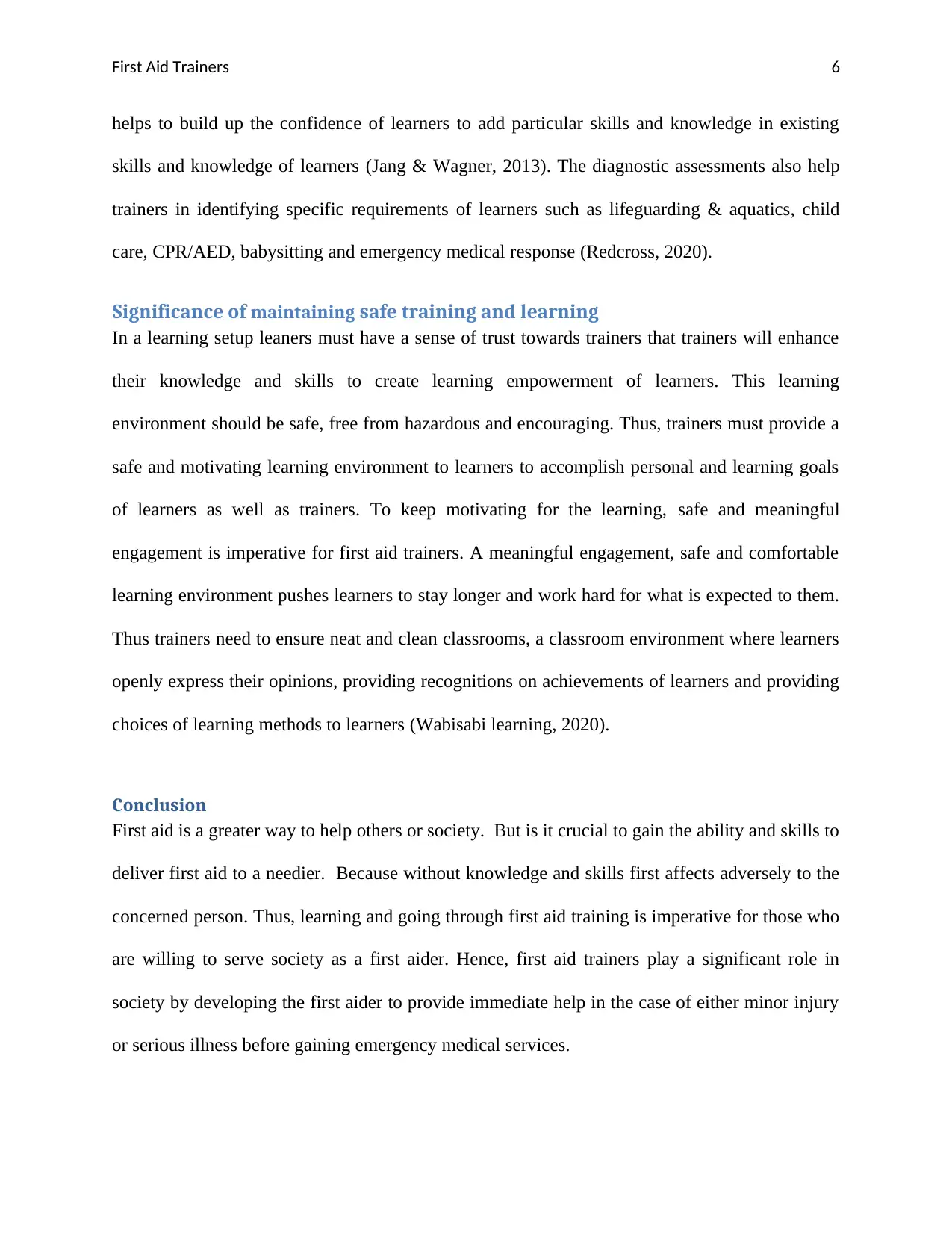
First Aid Trainers 6
helps to build up the confidence of learners to add particular skills and knowledge in existing
skills and knowledge of learners (Jang & Wagner, 2013). The diagnostic assessments also help
trainers in identifying specific requirements of learners such as lifeguarding & aquatics, child
care, CPR/AED, babysitting and emergency medical response (Redcross, 2020).
Significance of maintaining safe training and learning
In a learning setup leaners must have a sense of trust towards trainers that trainers will enhance
their knowledge and skills to create learning empowerment of learners. This learning
environment should be safe, free from hazardous and encouraging. Thus, trainers must provide a
safe and motivating learning environment to learners to accomplish personal and learning goals
of learners as well as trainers. To keep motivating for the learning, safe and meaningful
engagement is imperative for first aid trainers. A meaningful engagement, safe and comfortable
learning environment pushes learners to stay longer and work hard for what is expected to them.
Thus trainers need to ensure neat and clean classrooms, a classroom environment where learners
openly express their opinions, providing recognitions on achievements of learners and providing
choices of learning methods to learners (Wabisabi learning, 2020).
Conclusion
First aid is a greater way to help others or society. But is it crucial to gain the ability and skills to
deliver first aid to a needier. Because without knowledge and skills first affects adversely to the
concerned person. Thus, learning and going through first aid training is imperative for those who
are willing to serve society as a first aider. Hence, first aid trainers play a significant role in
society by developing the first aider to provide immediate help in the case of either minor injury
or serious illness before gaining emergency medical services.
helps to build up the confidence of learners to add particular skills and knowledge in existing
skills and knowledge of learners (Jang & Wagner, 2013). The diagnostic assessments also help
trainers in identifying specific requirements of learners such as lifeguarding & aquatics, child
care, CPR/AED, babysitting and emergency medical response (Redcross, 2020).
Significance of maintaining safe training and learning
In a learning setup leaners must have a sense of trust towards trainers that trainers will enhance
their knowledge and skills to create learning empowerment of learners. This learning
environment should be safe, free from hazardous and encouraging. Thus, trainers must provide a
safe and motivating learning environment to learners to accomplish personal and learning goals
of learners as well as trainers. To keep motivating for the learning, safe and meaningful
engagement is imperative for first aid trainers. A meaningful engagement, safe and comfortable
learning environment pushes learners to stay longer and work hard for what is expected to them.
Thus trainers need to ensure neat and clean classrooms, a classroom environment where learners
openly express their opinions, providing recognitions on achievements of learners and providing
choices of learning methods to learners (Wabisabi learning, 2020).
Conclusion
First aid is a greater way to help others or society. But is it crucial to gain the ability and skills to
deliver first aid to a needier. Because without knowledge and skills first affects adversely to the
concerned person. Thus, learning and going through first aid training is imperative for those who
are willing to serve society as a first aider. Hence, first aid trainers play a significant role in
society by developing the first aider to provide immediate help in the case of either minor injury
or serious illness before gaining emergency medical services.
Paraphrase This Document
Need a fresh take? Get an instant paraphrase of this document with our AI Paraphraser
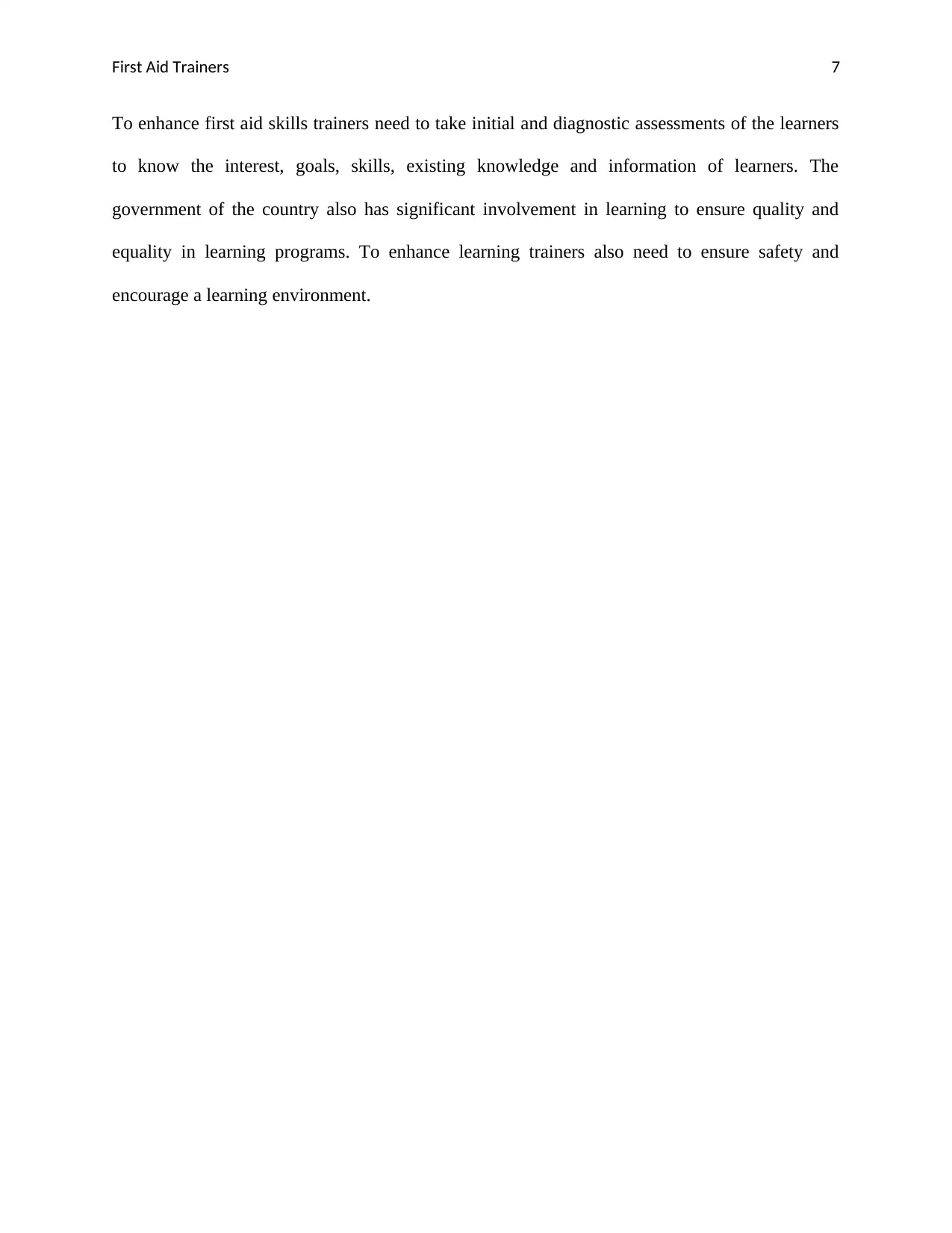
First Aid Trainers 7
To enhance first aid skills trainers need to take initial and diagnostic assessments of the learners
to know the interest, goals, skills, existing knowledge and information of learners. The
government of the country also has significant involvement in learning to ensure quality and
equality in learning programs. To enhance learning trainers also need to ensure safety and
encourage a learning environment.
To enhance first aid skills trainers need to take initial and diagnostic assessments of the learners
to know the interest, goals, skills, existing knowledge and information of learners. The
government of the country also has significant involvement in learning to ensure quality and
equality in learning programs. To enhance learning trainers also need to ensure safety and
encourage a learning environment.
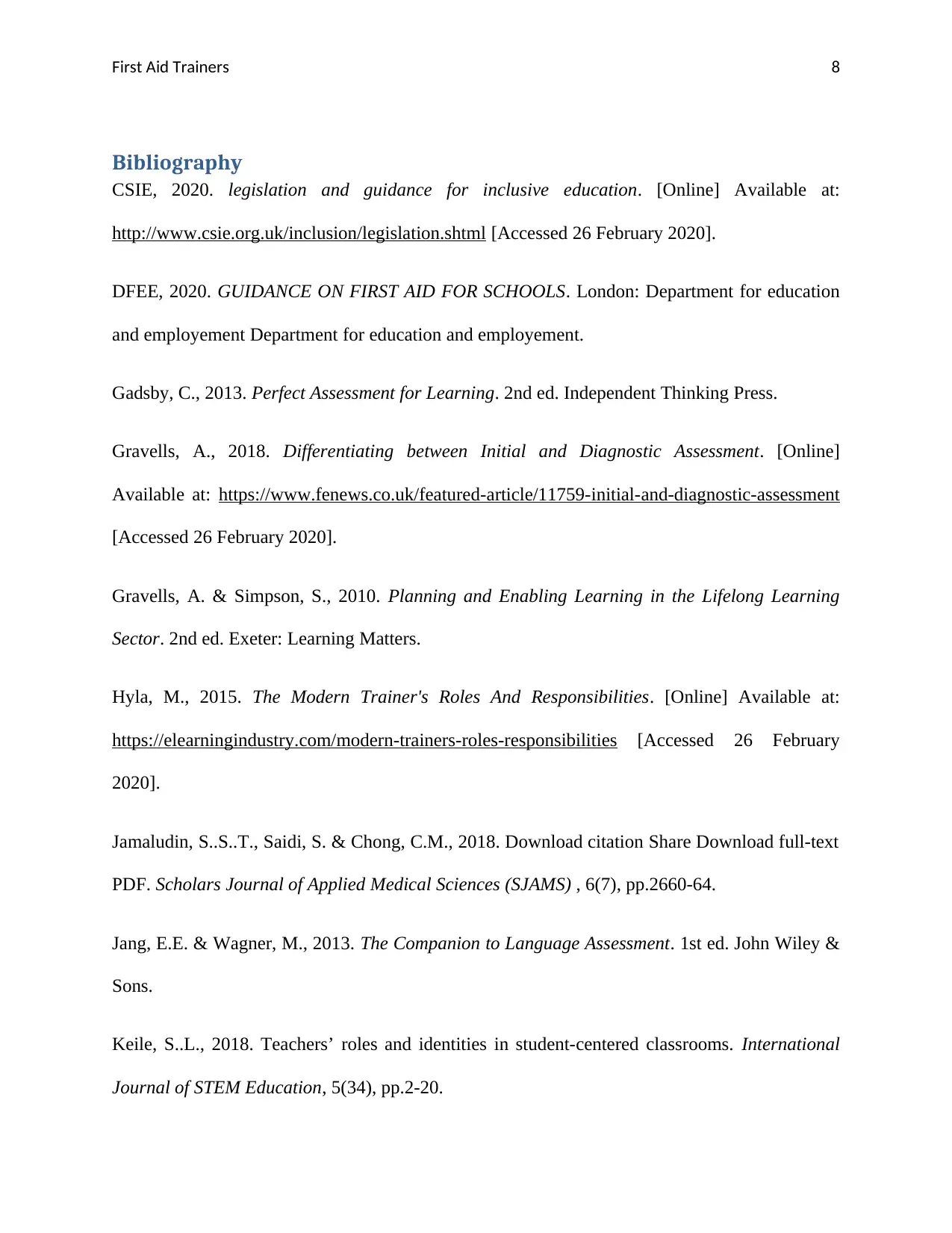
First Aid Trainers 8
Bibliography
CSIE, 2020. legislation and guidance for inclusive education. [Online] Available at:
http://www.csie.org.uk/inclusion/legislation.shtml [Accessed 26 February 2020].
DFEE, 2020. GUIDANCE ON FIRST AID FOR SCHOOLS. London: Department for education
and employement Department for education and employement.
Gadsby, C., 2013. Perfect Assessment for Learning. 2nd ed. Independent Thinking Press.
Gravells, A., 2018. Differentiating between Initial and Diagnostic Assessment. [Online]
Available at: https://www.fenews.co.uk/featured-article/11759-initial-and-diagnostic-assessment
[Accessed 26 February 2020].
Gravells, A. & Simpson, S., 2010. Planning and Enabling Learning in the Lifelong Learning
Sector. 2nd ed. Exeter: Learning Matters.
Hyla, M., 2015. The Modern Trainer's Roles And Responsibilities. [Online] Available at:
https://elearningindustry.com/modern-trainers-roles-responsibilities [Accessed 26 February
2020].
Jamaludin, S..S..T., Saidi, S. & Chong, C.M., 2018. Download citation Share Download full-text
PDF. Scholars Journal of Applied Medical Sciences (SJAMS) , 6(7), pp.2660-64.
Jang, E.E. & Wagner, M., 2013. The Companion to Language Assessment. 1st ed. John Wiley &
Sons.
Keile, S..L., 2018. Teachers’ roles and identities in student-centered classrooms. International
Journal of STEM Education, 5(34), pp.2-20.
Bibliography
CSIE, 2020. legislation and guidance for inclusive education. [Online] Available at:
http://www.csie.org.uk/inclusion/legislation.shtml [Accessed 26 February 2020].
DFEE, 2020. GUIDANCE ON FIRST AID FOR SCHOOLS. London: Department for education
and employement Department for education and employement.
Gadsby, C., 2013. Perfect Assessment for Learning. 2nd ed. Independent Thinking Press.
Gravells, A., 2018. Differentiating between Initial and Diagnostic Assessment. [Online]
Available at: https://www.fenews.co.uk/featured-article/11759-initial-and-diagnostic-assessment
[Accessed 26 February 2020].
Gravells, A. & Simpson, S., 2010. Planning and Enabling Learning in the Lifelong Learning
Sector. 2nd ed. Exeter: Learning Matters.
Hyla, M., 2015. The Modern Trainer's Roles And Responsibilities. [Online] Available at:
https://elearningindustry.com/modern-trainers-roles-responsibilities [Accessed 26 February
2020].
Jamaludin, S..S..T., Saidi, S. & Chong, C.M., 2018. Download citation Share Download full-text
PDF. Scholars Journal of Applied Medical Sciences (SJAMS) , 6(7), pp.2660-64.
Jang, E.E. & Wagner, M., 2013. The Companion to Language Assessment. 1st ed. John Wiley &
Sons.
Keile, S..L., 2018. Teachers’ roles and identities in student-centered classrooms. International
Journal of STEM Education, 5(34), pp.2-20.
⊘ This is a preview!⊘
Do you want full access?
Subscribe today to unlock all pages.

Trusted by 1+ million students worldwide
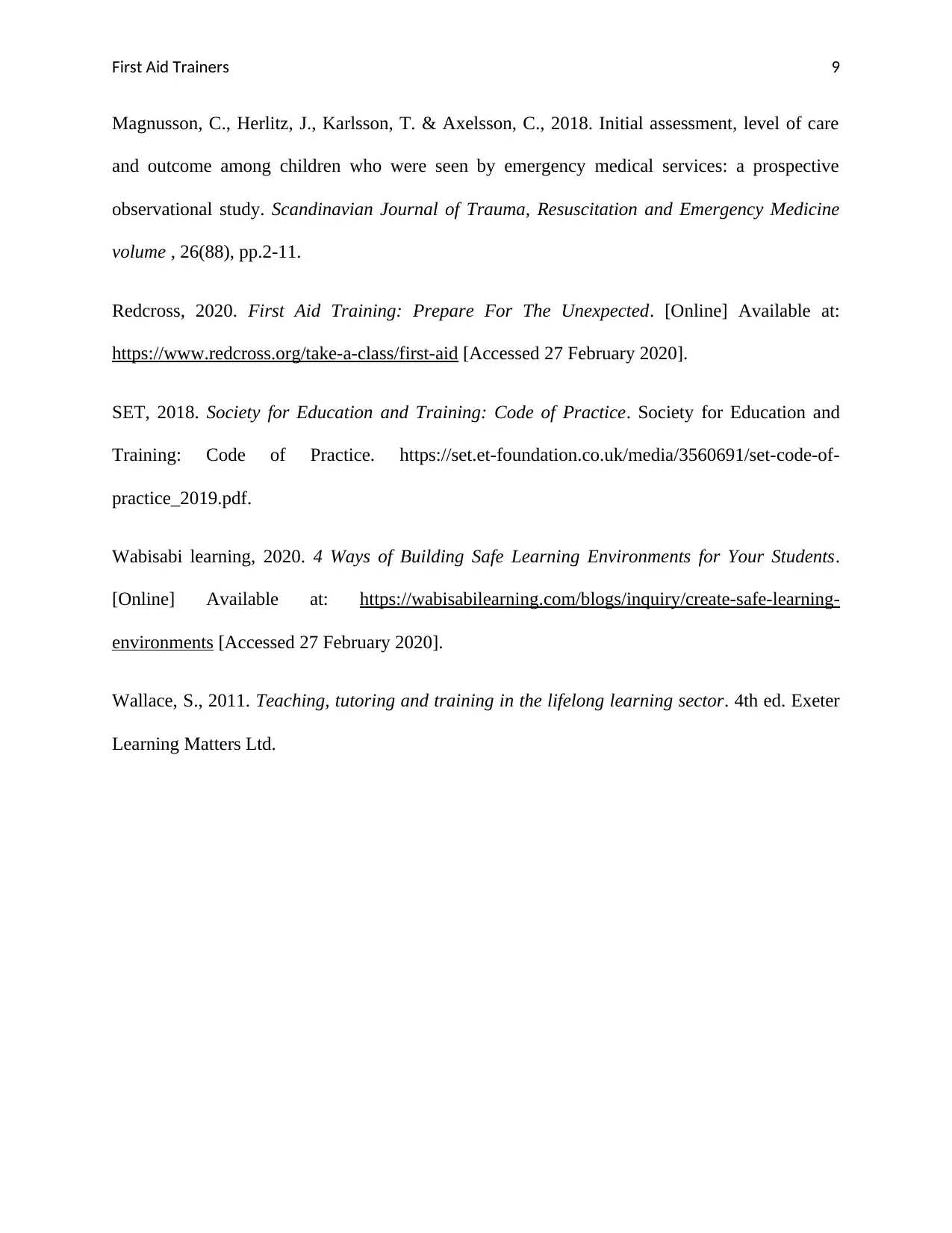
First Aid Trainers 9
Magnusson, C., Herlitz, J., Karlsson, T. & Axelsson, C., 2018. Initial assessment, level of care
and outcome among children who were seen by emergency medical services: a prospective
observational study. Scandinavian Journal of Trauma, Resuscitation and Emergency Medicine
volume , 26(88), pp.2-11.
Redcross, 2020. First Aid Training: Prepare For The Unexpected. [Online] Available at:
https://www.redcross.org/take-a-class/first-aid [Accessed 27 February 2020].
SET, 2018. Society for Education and Training: Code of Practice. Society for Education and
Training: Code of Practice. https://set.et-foundation.co.uk/media/3560691/set-code-of-
practice_2019.pdf.
Wabisabi learning, 2020. 4 Ways of Building Safe Learning Environments for Your Students.
[Online] Available at: https://wabisabilearning.com/blogs/inquiry/create-safe-learning-
environments [Accessed 27 February 2020].
Wallace, S., 2011. Teaching, tutoring and training in the lifelong learning sector. 4th ed. Exeter
Learning Matters Ltd.
Magnusson, C., Herlitz, J., Karlsson, T. & Axelsson, C., 2018. Initial assessment, level of care
and outcome among children who were seen by emergency medical services: a prospective
observational study. Scandinavian Journal of Trauma, Resuscitation and Emergency Medicine
volume , 26(88), pp.2-11.
Redcross, 2020. First Aid Training: Prepare For The Unexpected. [Online] Available at:
https://www.redcross.org/take-a-class/first-aid [Accessed 27 February 2020].
SET, 2018. Society for Education and Training: Code of Practice. Society for Education and
Training: Code of Practice. https://set.et-foundation.co.uk/media/3560691/set-code-of-
practice_2019.pdf.
Wabisabi learning, 2020. 4 Ways of Building Safe Learning Environments for Your Students.
[Online] Available at: https://wabisabilearning.com/blogs/inquiry/create-safe-learning-
environments [Accessed 27 February 2020].
Wallace, S., 2011. Teaching, tutoring and training in the lifelong learning sector. 4th ed. Exeter
Learning Matters Ltd.
1 out of 10
Related Documents
Your All-in-One AI-Powered Toolkit for Academic Success.
+13062052269
info@desklib.com
Available 24*7 on WhatsApp / Email
![[object Object]](/_next/static/media/star-bottom.7253800d.svg)
Unlock your academic potential
Copyright © 2020–2025 A2Z Services. All Rights Reserved. Developed and managed by ZUCOL.



